| 501-10A Front Seats | 2013 - 2014 Fusion |
| Description and Operation | Procedure revision date: 07/17/2013 |
System Operation
System Diagram - Memory Seat

Network Message Chart - Memory Seat
DSM Network Input Messages
| Broadcast Message | Originating Module | Message Purpose |
|---|---|---|
| Key-in-ignition status | BCM | Provides the ignition position. This input is used for the easy entry/exit feature. |
| Personality recall | BCM | When the personality recall command is received from the BCM , the DSM stores or recalls the associated memory seat position (1, 2 or 3). If a RKE transmitter has been programmed to a memory position, this input is used to recall the associated memory seat position. To program the RKE transmitter, REFER to the Owner's Literature. |
| Memory seat switch status | DDM | When the memory set switch (1, 2 or 3) is activated, the DDM sends this message to the DSM , which then stores or recalls the associated memory seat position. |
System Diagram - Heated Seats

Network Message Chart - Heated Seats
FCIM Network Input Messages
| Broadcast Message | Originating Module | Message Purpose |
|---|---|---|
| Climate control requests | FCIM | The climate control requests message contains the heated seat request information. |
FDIM Network Input Messages
| Broadcast Message | Originating Module | Message Purpose |
|---|---|---|
| Climate control button status | FCIM | The climate control button status message provides the current status of the heated seat button(s) to the FCIM for the purpose of updating the displayed status of the heated seat buttons on the FDIM (touchscreen). |
Memory Seat Operation
The driver seat control switch provides a voltage signal to the DSM only when activated. This voltage signal causes the DSM to power the appropriate motor until the input is removed. The motor circuits are normally grounded through the DSM . The DSM internally switches the appropriate circuit from ground to voltage to operate the motors.
As the seat is adjusted, the DSM monitors the motor position sensors to record the current seat position. The DSM removes voltage from the motor upon termination of the seat control switch input or if the DSM does not detect movement from the motor while monitoring the position sensor during a memory recall operation.
DSM Hard Stop/Soft Stop
The DSM has the ability for soft stops both at the upper and lower limits on all axes of the driver seat. When an axis reaches the hard stop and the switch is held for approximately one second, it then backs up 180 ms and establishes the soft stop for that axis in that direction. The DSM uses this back up strategy to check sensor integrity any time movement has stopped prematurely due to a sensor failure or obstruction.
A hard stop occurs when one of the memory seat track axes or backrest recline physically reach the end of travel and can go no further. A soft stop occurs when the seat stops before physically reaching the end of travel. The hard stop is set by seat design and cannot be changed or adjusted. The soft stop is set by the DSM . The seat track axes are forward/rearward, front height and rear height. The backrest axis is recline forward/backward. To prevent unnecessary stress on the seat and motors, the DSM sets soft stop positions, 2 for each moving axis. The DSM uses a preset distance from the hard stop to determine where the soft stop occurs. When an axis reaches the hard stop and the switch is held for approximately one second, the DSM establishes the soft stop for that axis in that direction.
Easy Entry/Exit
The easy entry/exit feature is a function of the DSM that moves the driver seat back approximately 50.8 mm (2 in) (unless seat is already positioned at or near the end of travel) when the ignition key is removed from the ignition switch (without keyless entry) or the ignition is turned off (with keyless entry). The DSM receives a key-in-ignition status over the Medium Speed Controller Area Network (MS-CAN) and operates the driver seat rearward. The DSM cancels this operation if a valid input command is received from the driver seat control switch, memory set switch, exterior mirror control switch or if the function has been disabled.
The DSM records the current seat positions before operating the seat for an easy exit operation. During easy entry operation (when the key is put back in the ignition [without keyless entry] or the ignition is turned on [with keyless entry]) the seat is returned to the recorded seat position previous to the easy exit operation. Easy entry operation is cancelled if a valid input command is received by the DSM . A memory position recall using the memory set switch also overrides the easy exit operation.
The easy entry/exit feature can be enabled/disabled on the message center. For information on programming vehicle settings in the message center, refer to the Owner's Literature.
Heated Seat Operation
The driver and passenger heated seat control buttons and indicators are located on the FCIM . The heated seat system functions independently of the climate control system. Each time the heated seat button is pressed, the FCIM decreases one setting (the sequence is hi, low, off, hi, etc.). When a heated seat is set to hi, both LED indicators above that heated seat's control button illuminate. When a heated seat is set to low, only one LED indicator above that switch illuminates. When off, no indicators illuminate.
If equipped, the driver and passenger heated seat buttons are selected from the FDIM (touchscreen). The FDIM is mounted directly to the APIM . The heated seat system functions independently of the vehicle's climate control system. Each time the heated seat button is pressed, the APIM sends the request to the GWM using the Infotainment Controller Area Network (I-CAN). The GWM sends the message to the FCIM which decreases one setting (the sequence is high, low, off, high, etc.).
When activated, the FCIM supplies voltage to the selected seat heater circuit. Each seat cushion heater mat and backrest heater mat is connected in a series circuit to the FCIM and powered by the output circuit for that seat. The FCIM monitors inputs from a temperature sensor located in each seat cushion heater mat, and maintains seat temperature by cycling the heater circuits on/off. The heated seat remains ON until the heated seat switch button is pressed to cycle the FCIM OFF or the ignition is set to OFF.
If a fault is detected by the FCIM , the module stops supplying voltage to that individual left or right seat that the fault was detected on until the ignition is turned OFF and then ON.
Remote Start Heated Seat Operation (if equipped)
The customer can select different climate control/heated seat modes/preferences when the vehicle is started using the remote start feature. This can be accessed through the message center. For additional information on how to set the remote start preferences, refer to the Owner's Literature. When the driver seat and/or passenger seat is set to AUTO mode, the driver/passenger heated seat activates when the outside temperature is less than 0° C (32° F) any time the vehicle is started using the remote start feature. No heated seat adjustments are recognized during remote start operation. When the ignition is cycled to the ON position after a remote start event, the heated seat switches off.
Component Description
Seat Control Switch - Without Memory
The seat control switch contains normally closed contacts (which are grounded). When a specific adjustment position is selected, an individual circuit is switched to voltage.
Seat Control Switch - With Memory
The seat control switch is hard-wired to the DSM , which controls seat operation. When a specific seat adjustment position is selected, an individual circuit is switched to voltage.
DSM
The driver seat control switch and power memory seat motors are hard-wired to the DSM . The DSM controls the operation of the power memory seat. The DSM communicates on the MS-CAN . PMI is required when a new DSM is installed. The DSM hard stop/soft stops must be set/reset any time a new DSM , driver seat track or driver seat backrest is installed.
Memory Set Switch
The memory set switch contains 3 momentary contact switches. It is hard-wired to the DDM and is used to recall 1 of 3 memory positions stored in the DSM .
Seat Track - Without Memory
There are 3 front seat track bi-directional motors present on power seat tracks. The horizontal (fore/aft) front seat track motor is the only seat track motor which can be serviced separately from the seat track assembly. All other seat track motors (front height, rear height) are serviced as part of the seat track assembly. The seat track motors move the power seat forward/backward and up/down depending on the polarity of voltage supplied from the seat control switch.
Seat Track - With Memory
There are 3 front seat track bi-directional motors present on power seat tracks. The horizontal (fore/aft) front seat track motor is the only seat track motor which can be serviced separately from the seat track assembly. All other seat track motors (front height, rear height) are serviced as part of the seat track assembly. Each seat track motor contains a Hall-effect sensor which provides seat track position information to the DSM for setting/obtaining desired preset seat memory positions. The seat track motors move the power seat forward/backward and up/down depending on the polarity of voltage supplied from the DSM .
Seat Backrest - Without Memory
The seat backrest contains a bi-directional motor which is integral to the seat backrest assembly. The seat backrest motor moves the seat backrest forward/backward depending on the polarity of voltage supplied from the seat control switch.
Seat Backrest - With Memory
The seat backrest contains a bi-directional motor which is integral to the seat backrest assembly. The seat backrest motor contains a Hall-effect sensor which provides seat backrest position information to the DSM for setting/obtaining desired preset seat memory positions. The seat backrest motor moves the seat backrest forward/backward depending on the polarity of voltage supplied from the DSM .
FDIM
If equipped, the FDIM (touchscreen) contains the heated seat control buttons.
FCIM
The FCIM contains the heated seat control buttons and also monitors the seat cushion temperature sensor and supplies heater current to the seat cushion and backrest heater mats until the desired setpoint temperature is reached. Once the setpoint temperature is reached, the FCIM cycles the heater circuits on/off as required to maintain the setpoint temperature.
Heater Mat
The seat cushion heater mat is equipped with a temperature sensor (thermistor) which provides feedback to the FCIM . The backrest heater mat can be serviced separately from the cushion heater mat. The cushion and backrest heater mats are connected in series.
Copyright © Ford Motor Company